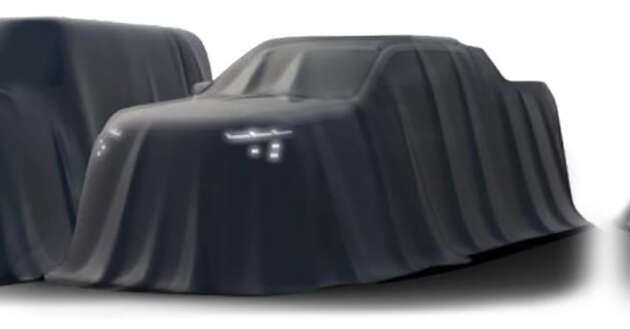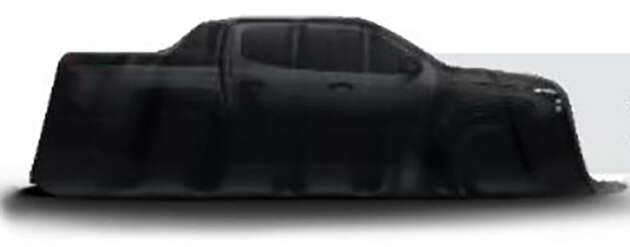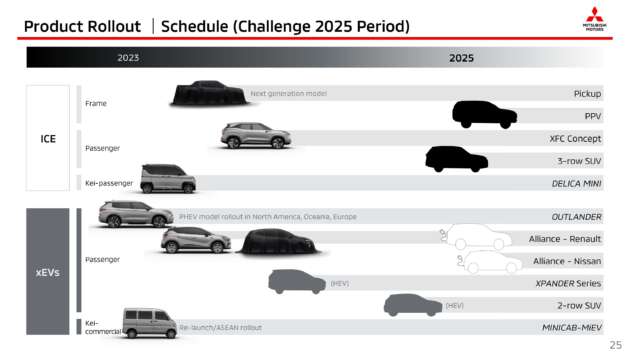Mitsubishi teased the next-generation Triton recently when it presented its ‘Challenge 2025’ mid-term business plan, which will be in effect from fiscal year 2023 to 2025 (FY2023 to FY2025). This is the follow-up to its ‘Small but Beautiful’ strategy presented back in 2020 and the next step in a long-term roadmap leading up to 2035.
According to the Japanese carmaker, it plans to roll out 16 models over the next five years, including nine xEV models (the generic term is used to described electrified vehicles). Specific to the certain regions, including the very important ASEAN, 12 models, including seven xEVs, will be launched in the same amount of time.
The sixth-generation Triton (simply labelled as ‘Pickup’) is one of the vehicles depicted in the presentation slide, although we can only make out its distinctive light signature. In detail, we can see three sets of “hockey stick-shaped” light bars accompanied by three lit squares on either side. It’s highly likely the dual-tier lighting arrangement of the fifth-generation Triton will be carried over, as suggested by spyshots of prototypes in Thailand.
Mitsubishi did not say precisely when the new Triton will make its world debut, but based on another slide, it will be sometime this year. A report by Headlightmag claims the Triton will be built on the current Nissan Navara’s ladder-frame chassis, which will result in a larger vehicle inside and out.
There’s some evidence to back this claim, as in the same slide, we get a side view of the upcoming Triton that shows a similar window line – we’ll need to wait to confirm. Mitsubishi has been part of the Alliance with Renault and Nissan since 2016, so platform sharing is always a possibility and, for certain models, already a certainty.
Turbodiesel power will be a definite for the new Triton, but the pick-up truck could also be offered with a fully electric powertrain. Placed right beside the covered Triton is an unnamed model simply labelled ‘Pickup BEV’ that should challenge the production version of the Toyota Hilux Rev BEV concept revealed last December.
Aside from the Triton, Mitsubishi also has a Pickup Platform Vehicle (PPV) on the way, which is very likely a new generation of the Pajero Sport. The current, third-generation Pajero Sport is related to the fifth-generation Triton and is a passenger-focused SUV with three-row seating. However, Mitsubishi’s new PPV won’t be arriving anytime soon, as the timeline shows a debut only taking place in 2025.
Also mentioned during Mitsubishi’s presentation is a new generation of the Xpander, which it says has been highly regarded since it was launched in 2017. This one is pointed out clearly with the covered vehicle marked ‘Xpander HEV’, which confirms hybrid power is coming to the seven-seat MPV.
Another model due to arrive in FY2023 is a two-row SUV previewed by the XFC Concept in October 2022. This will come with a “Wet mode” that is being introduced for the first time in a Mitsubishi vehicle. The company says it is designed for use in ASEAN countries in mind, enabling safe driving even on flooded roads with plenty of ground clearance.
Mitsubishi wasn’t explicit in pointing out which of the vehicles in the slide is the production XFC Concept, but the ‘2-row SUV BEV’ and ‘2-row SUV HEV’ are likely representatives and indicative of the powertrains that will be made available.
As for the rest of the models, they are an MPV, a three-row SUV, an Alliance BEV and a MPV with hybrid power. For other regions, there will be a new kei car, the Colt (based on the Renault Clio) and another Alliance BEV.
With the Challenge 2025 business plan, Mitsubishi is aiming for a sales volume of 1.1 million vehicles and operating profit of 220 billion yen (around RM7.37 billion) in FY2025. The company will also increase investment by around 30% over the six years to 2028 in R&D and capital expenditure to support these goals.
Carbon neutrality is also a focus point, with targets to reduce average tank to wheel CO2 emissions from new vehicles by 40% by 2030. This will see the powertrain mix shift from a mix of internal combustion engine (ICE), hybrid (HEV) plug-in hybrid (PHEV) and battery electric (BEV) cars to mainly HEV, PHEV and BEV by 2030, with mainly BEVs making up the mix by 2035.
The company says it expects xEVs to make up 50% of the sales mix by 2030, with 100% by FY2035. Investing in battery procurement is another one of Mitsubishi’s missions to enable this, with 210 billion yen (around RM7.03 billion) being allocated to procure 15 GWh by 2030.
Source: Read Full Article




